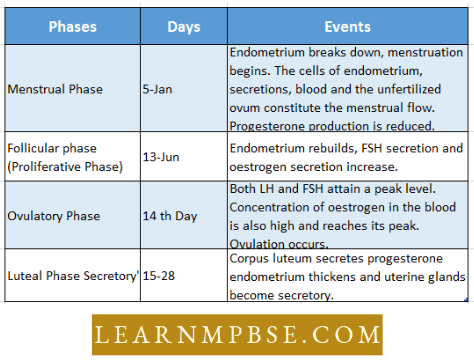NEET Biology Animal Reproductive System
- Embryology: It is the study of events and changes that take place from fertilization to the hatching or birth of an individual and includes the changes of the prenatal period only.
- Developmental Biology: It is the study of the ontogenic development process by which organism undergoes changes in their structure and physiology during their entire life and includes the entire changes from fertilization to death.
- Reproduction: The process of producing the young ones of its type is called reproduction.
NEET Biology Animal Reproductive System Forms Of Reproduction
Asexual and Sexual reproduction are the two main forms of reproduction in animals.
- Asexual Reproduction: It is a type of multiplication in which an offspring is formed from a specialized or unspecialized part of the parent without the formation and fusion of sex cells and the process is termed blastogenesis.
Basic features of asexual reproduction:
- Only one parent is involved.
- All the cell divisions are mitotic.
- All the offspring are genetically similar to the parent.
- The reproductive unit is a fragment or specialized part of the parent.
Read and Learn More NEET Biology Notes
The different ways of asexual reproduction are :
- Budding, fission, fragmentation, plastotomy, etc. Budding may be external ExamplePorifers and Hydra) or internal Example Spongilla).
- Fission may be binary Example Euglena) or multiple (Plasmodium)
Fragmentation Example Earthworm), Sporulation ExampleAmoeba) Another asexual method is either androgenesis or gynogenesis.
- Fission may be binary Example Euglena) or multiple (Plasmodium)
- Sexual Reproduction: It is a type of reproduction that takes place through the formation and fusion of gametes and form zygotes and undergoes division to form an embryo, the process is termed embryogenesis.
Reproductive System In Animals NEET Notes
Types Of Sexual Reproduction
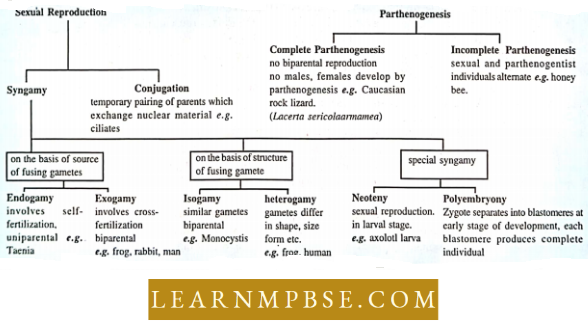
Basic features of sexual reproduction
- Development of male and female organs.
- Meiosis occurs in the life cycle.
- Production of a large number of male and female gametes.
- Motility of male gametes.
- Hie two types of gametes fuse and they produce a diploid structure called a zygote.
- A zygote produces an embryo by different changes.
- Only the mature individuals can produce the gametes.
NEET Biology Animal Reproductive System Sexual Reproduction In Humans
The reproductive system is formed of primary sex organs, viz. testes and ovaries, which produce haploid gametes by meiosis.
- Secondary sex organs, organs that perform important functions in reproduction but neither produce gametes nor secrete sex hormones, are called secondary sex organs, Example prostate and seminal vesicles, Cowper’s glands in male and fallopian tubes, and also produce sex hormones uterus and vagina in the female.
- Accessory sex organs are the distinct structures or characters that distinguish the sex of a species in appearance viz. facial hair, broad larynx, etc. in males and breasts in females.
NEET Biology Animal Reproductive System Male Reproductive System
It is formed of testes present in the scrotal sacs; epididymis to store the sperms; vasa deferentia for conduction of sperms and penis as an intromittent organ. Testis consists of numerous coiled seminiferous tubules (crypts). Each is lined by germinal epithelium formed of germ cells and Sertoli (nurse) cells. Germ cells produce spermatozoa which obtain nutrition from the sertoli cells.
- The interstitial cells (Leydig’s cells) of the testis produce the male sex hormone, testosterone. Secondary sex glands of males include a prostate, two seminal vesicles, and two Cowper’s glands. The secretion of these glands, along with the sperms, form the semen.
- The human male reproductive system includes the testes, epididymis, vasa deferentia, seminal vesicle, prostate gland, urethra, bulbourethral gland, and intromittent organ penis.
- The Testes (Spermaries) or Male Gonads
- In the embryo, the testes develop along the posterior wall of the abdomen. Shortly before birth, they descend into a fleshy sac scrotum which hangs away from the body wall between the thighs. The penis and scrotum together constitute the male external genitalia.
- If the testes do not descend, sterility occurs because normal sperm production is inhibited by internal body temperature, hence a cooler temperature is required. Temperature in the scrotum is about 2 to 3° C cooler than those in the abdomen. Failure of the testes to descend into the scrotal sac is called cryptorchidism.
- In the wall of the scrotum, there is a layer of smooth muscle, the dartos muscle, which responds to changing temperature. In the cold, this muscle contracts, and the testes are drawn closer to the abdomen for warmth, while heat causes the muscles to relax and the testes descend further for cooling.
- Internally, the testes are subdivided roughly into many compartments, each of which contains tightly coiled tubules, the seminiferous tubules, where sperms are produced by spermatogenesis from sperm mother cells.
- Along the outer wall of these tubules, are specialized cells, called spermatogonia.
- Surrounding the spermatogonia and the developing sperm are large cells called Sertoli cells. These cells provide protection, support, and nourishment to the developing sperm. Sertoli cells provide a barrier that protects sperm from an attack by the body’s immune system.
- After puberty, millions of sperm mature each day. A male continues to make sperm from puberty until death, though the number of living sperm arc reduces with age.
- Each ejaculation releases semen (a volume of fluid containing up to 300 million
sperm). If a male releases fewer than 60 million sperm is usually considered infertile.
Reproductive System In Animals NEET Notes
NEET Biology Animal Reproductive System Transport Or Sperms
- Maturing spends are washed down in scmmilcnnis mimics by scaling Irom Sertoli cells and begin a long journey that may end in lentil/nylon.
- From die tubules, (be sperms enter the epididymis, then the vas deferens, and eventually the urethra. Along the way. three accessory glands – the seminal vesicles i.e., And the bulbourethral glands, contribute secretions.
- Together with the sperm, these secretions form semen. Tint semen is a thick whitish fluid that contains fluid from accessory glands.
- In each testis, the epididymis is a long coiled tube, where the sperm can be stored while they mature. The wall of the epididymis contains smooth muscle which can contract rhythmically to propel the sperm into the vas deferens during ejaculation
NEET Biology Animal Reproductive System Female Reproductive system
It comprises a pair of ovaries, two fallopian tubes, a uterus, and a vagina. Each ovary is encased by germinal epithelium composed of germ cells that develop into primary follicles.
- A primary follicle transforms into a Graafian follicle due to the action of FSH. Ovulation is regulated by luteinizing hormone (LH). The ovaries secrete estrogens and progesterone hormones.
- The fallopian tubes transport the ovum to the uterus, which serves as the site for fetal development throughout gestation, while the vagina functions as the delivery canal. The vulva is the external genitalia of females.
- Breasts are secondary sexual characteristics in females. Their size is contingent upon ovarian estrogens throughout puberty and lactogenic hormone following parturition.
NEET Biology Animal Reproductive System Female Gonads The Ovaries
The paired ovaries produce an egg each month. Ovaries lie on the lateral wall of the upper pelvic cavity and are held in position by supportive ligaments.
- Each ovary’ is covered with a layer of germinal epithelium. Within this covering, there are small sac-like structures, called ovarian (Graafian) follicles.
- These follicles pass through different stages of development: primary follicles, secondary follicles, and mature follicles.
- The small primary follicle consists of a single layer of cells and contains an immature ovum. The follicle cells support and protect the developing ovum and also produce the hormone estrogen, which maintains a woman’s secondary sex characteristics.
- The larger secondary follicle develops from the primary follicle and supports the maturation of the ovum.
- The next stage is the graafian follicle which has several layers of cells and a fluid-filled cavity surrounding the developing ovum.
- The immature ovum released from the Graafian follicle is called ovulation. Ovulation occurs about once a month. After ovulation, the follicle structure changes into a hormone-secreting structure, the corpus luteum, before degrading.
- The development of the follicle and the release of an immature ovum at ovulation are both initiated and controlled by follicle-stimulating hormone (FSH) and luteinizing hormone (LH) from the pituitary gland. The ovum will become completely mature only if it is fertilized by a sperm.
- At the time of birth, a female baby has about 500000 primary oocytes. During her life, she will make no more, most of them will degenerate before puberty. Only about 500 will develop sufficiently to be released by ovulation.
NEET Biology Animal Reproductive System Oviducts (Fallopian tubes)
The two oviducts transport the secondary oocyte to the uterus. One end of each tube attaches to the uterus, while the opposite end develops into a funnel-shaped structure known as fimbriae, which loosely encircles the ovary. Fertilization often transpires in the proximal portion of the fallopian tube.
NEET Biology Animal Reproductive System Uterus
The uterus is a hollow pc. un-shaped muscular urgim. where the fertilized ovum grows and develops.
- It is Emily covered the peritoneum mid-the cavity is lined by endometrium llieuicuis consisting of men: the hotly (expanded upper portion; the lathis (consoled rental pot lion) and the cervix.
- The ss. ill ol the Julius contains three distinct layers. The oilier thin covering ipcritoneunO is an eontinumion of die peritoneal membrane. ‘The middle link layer (myometrium) contains smooth muscles.
- The inner lining, called endometrium contains abundant blood vessels and glands to nourish and protect the embryo.
- li fertilization occurs, the early embryo burrows into this layer through a process called implantation. If fertilization and implantation, do not occur, portions of this layer are shed and replaced every month during the menstrual cycle.
Male And Female Reproductive System NEET
NEET Biology Animal Reproductive System Vagina
- The vagina is a flexible muscular tube extending from the cervix to the body’s exterior. The female genitalia are collectively called the vulva.
- The vulva includes two sets of fleshy folds called labia, the mons pubis, and the clitoris.
- The female reproductive system has five major functions.
- It produces and transports the female gametes and receives the sperm of the male.
- It provides a site for fertilization.
- It supports, protects, and nourishes the development of the fertilized egg, embryo, and fetus.
- It provides a birth canal for the newborn infant.
- In addition to these reproductive functions, the female produces milk from mammary glands to nourish the newborn child.
- The primary organs that accomplish these tasks are a pair of ovaries, a pair of uterine tubes (oviducts or fallopian tubes), a uterus, and the vagina.
NEET Biology Animal Reproductive System The Menstrual Cycle
NEET Biology Animal Reproductive System Puberty
It is the period of sexual maturity. It comes between 13 to 16 years in the male and between 10 to 14 years in the female.
It is controlled by testosterone in the male and estrogens in the female. It is characterized by the development of secondary sexual characters.
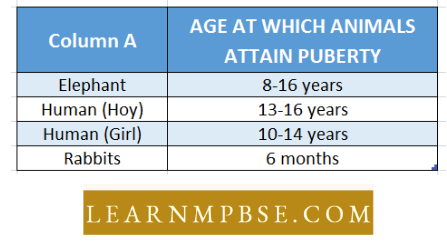
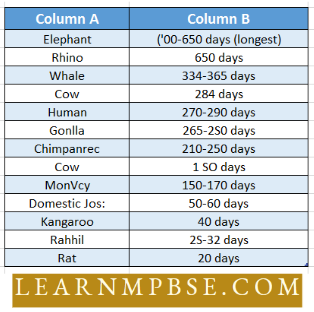
- Precocious puberty: Normally a woman’s fertile life starts from the age of puberty (about 13 years), but under some abnormal conditions like high levels of sex hormones (LH and FSH), menstruation starts at an earlier age than normal, it is called precocious puberty.
- Orgasm in females: During intercourse, under the influence of various stimuli, the female becomes excited. The clitorial and genital folds swell and the vaginal wall secretes a moist lubricating fluid.
- The breasts swell and the nipples become erect. Orgasm is associated with the contraction of the vaginal wall. At orgasm, the cervix drops down into the upper portion of the vagina and creates a syringing action on the pool of semen.
- Parturition: It is a process of expulsion of a fetus from the uterus. It starts at the end of pregnancy. It takes place by the rhythmic contractions and propulsion movements of the uterine wall.
- The cervix becomes soft and dilates at that time. The tire fetus is pushed down into the genital passage. Generally, the head comes out first. If legs come first then the baby is called a breech baby.
- The period of the year when an animal may breed is called breeding season For Example autumn for sheep and spring and autumn for bitches. The estrous cycles run only’ during the breeding season in monoestrous animals.
- The estrous cycles run throughout the year in polyestrous animals Example Cow, Buffalo.
- The suspension of the estrous cycle in female animals throughout the non-breeding season is called the state of anoestrum.
Male And Female Reproductive System NEET
NEET Biology Animal Reproductive System Memory Points
- Cow and buffalo are continuously breeding animals.
- The ovum or egg is the largest cell of the body.
- Monarch. The onset of the menstrual cycle in females is termed menarche.
- Most birds possess only the left ovary and the left oviduct for conveying the ovum released from the ovary, the right ovary and right oviduct being rudimentary vestiges.
- The left oviduct leads to a swollen tube called a shell gland. When the egg reaches here through the oviduct, the shell gland deposits calcium salts on it to form the eggshell.
- Uterine milk. Nutritive endometrial secretion.
- Miscarriage or Abortion. Loss of embryo due to breakdown of endometrium due to lowering of progesterone secretion from corpus luteum.
- Colostrum. ‘I the fluid released from the nipples a few days after parturition. It is ri(h in protein globulin and low in fat. It transfers antibodies from mother to baby.
- Mali-, have high IJMK due to greater activity.
- Vitellogenesis. Synthesis of yolk in primary oocyte during prophase.
- The side of the ovum that extrudes polar bodies is known as an animal pole and the opposite side is a vegetal pole.
- In a woman’s loiillily period of 32 yours, about 13 eggs mnlurr ouch year .mil on about eggs have chance In reach maturity.
- Ovulation in human female lakes placed on Mill clay of menstrual cycle which is 28 a. 2-day cycle.
- Ovulation. Release of ovum during the menstrual cycle is due To a large concentration of 11 on the Mill day of the menstrual cycle.
- Menstrual bleeding is caused due to the reduction in concentration of both estrogen and progesterone especially progesterone During the first trimester of pregnancy, the corpus luleum secretes the progesterone hormone which maintains pregnancy.
- Chorionic gonadotropin is secreted from the placenta which is formed during pregnancy only.
- At the time of parturition (Childbirth), the hormone secreted is relaxin, which relaxes the pubic ligaments and helps in childbirth.
- The ovaries contain 2 million or more primary oocytes 6 months before birth about a million at the time of birth and only 400,000 remain by the time of puberty.
NEET Biology Animal Reproductive System Important Terms
- Microgamete: (sperm) small-sized, haploid, motile gamete that is deficient in stored nutrients is a tanned microgamete.
- Macroganiete: (Ovum or female gamete). It is large-sized, non-motile, haploid, laden with nutrients is called macrogamete.
- Isogamy: The fusion of similar gametes is called isogamy. e.g Monocystis.
- Anisogamy: The fusion of gametes that are different in form, size, and behavior is termed anisogamy, such gametes are termed heterogametes, e.g. frogs, human
- Estrous Cycle: It consists of a few days of estrous (heat) followed by a few days of anoestrous. There is no bleeding and endometrium is reabsorbed.
- Semen: It is a fluid which is usually ejaculated only after the penis has been stimulated during sexual excitement. It contains sperms (about 200-400 million per 3 ml.), secretions of various reproductive glands, fibrinogen, thromboplastin, and calcium citrate.
- Corpus tuteum: The ruptured Graafian follicle after ovulation is called corpus Iuteum and secrete progesterone hormone into blood.
- Spermatic cord: It is an elastic cord that passes through the inguinal canal and is attached to the testis.
- The gubernaculum Mesometriun: is a fibromuscular tissue that binds the testis with the scrotal sac.
- Sertoli cells: Sertoli cells = Nurse cells = subtesticular cells. •
- Graafian follicleMesometriun: discovered by Regnier de Graff.
- Antrum: Antrum fluid-filled space in Graafian follicle
- Mesometriun: Mesometriun Fold of peritoneum lining which encloses the uterus and vagina
- Mesovarium: Fold of the peritoneal membrane that surrounds the ovary in frog
- Mesosalpinx: The fold of the peritoneal membrane that surrounds the fallopian tube.
- Mesorchium: The fold of the peritoneal membrane surrounds the testes in frogs.
In male frogs, nuptial pads are found at the metacarpals of 1st digit of the forelimb. These are also known as copulatory pads.
- The two fundamental methods of reproduction are asexual and sexual reproduction.
- Monocystis, Plasmodium, and Paramecium are acellular protists that reproduce sexually.
- Pseudopodiosporcs. During multiple fission in cysted amoeba many minute amoebae are formed termed pseudopodiospores.
- Gemmules are formed as internal buds (endogenous) covered by opaque envelopes in porifers such as Spongilla.
- Conjugation in Paramecium. It is the gametic nuclei fusion between two conjugating individuals through the cytoplasmic bridge.
- Animals with ability are termed as Hermaphrodite
The development of an unfertilized ovum into a new individual is called parthenogenesis. - The mature follicles are termed Graafian follicles. Rete-testis are cuboidal epithelium lined channels from which arise 10-20 fine tubules termed ductules efferent- tia.
- Mesovarium. The peritoneal membrane by which ovaries are suspended from the wall of the pelvic cavity.
- Cumulus oophorus. A heap of granulosa cells by which oocyte adheres to the wall of the follicle.
- Corpus lutcum. The granulose cells and interstitial cells form a mass of large yellowish conical cells after ovulation.
- c& Follicular atresia. Follicles in the ovaries that undergo regression and disappear due to death and are disposed of by phagocytes during the reproductive years of females are referred to as follicular atresia.
- Hormonal control of the male reproductive system The hypothalamus has ultimate control of the testes’ sexual function because it secretes a hormone called gonadotrophic releasing hormone (GnRH) that stimulates the anterior pituitary to produce the gonadotrophic hormones.
- There are two gonadotrophic hormones: follicle-stimulating hormone (FSH) and luteinizing hormone (LH), in both males and females. In males, FSH promotes spermatogenesis in the seminiferous tubules which also release the hormone inhibin. Inhibin acts to inhibit luteinizing hormone secretion by the anterior pituitary gland.

Reproduction In Animals NEET
- LH in males is sometimes given the name Interstitial cell-stimulating hormone (ICSH) because it controls the production of testosterone by the interstitial cells, scattered in the spaces between the seminiferous tubules.
- All these hormones are involved in a negative feedback relationship that maintains the constant production of sperm and testosterone.
- Testosterone is the main sex hormone in males. It is essential for the normal development and functioning of the male reproductive organs. Testosterone is also necessary for the maturation of sperm.
- Testosterone brings about and maintains the male secondary sex characteristics that develop at the time of puberty. It is responsible for the greater muscle strength of males, and this is the reason some athletes take supplemental amounts of anabolic steroids which are either testosterone or related chemicals.
- Hormonal control of the female reproductive system Mature females produce two sex hormones: estrogen and progesterone. Both are produced in the ovary by the specialized cells.
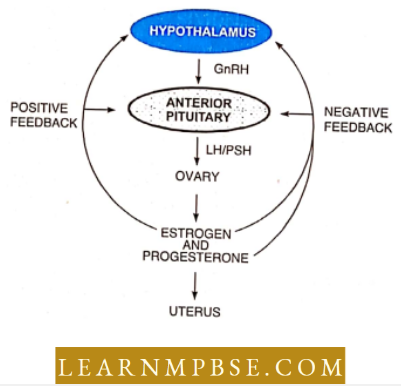
- During puberty, the anterior pituitary begins releasing LH and FSH together, L.H. and FSH stimulate the ovaries to produce estrogen and progesterone.
- Estrogen is responsible for the development of secondary sexual characteristics and for cyclic changes in the vaginal epithelium and endothelium of the uterus.
- Estrogen is also responsible for contour changes in the pelvis and the distribution of fat under the skin. Progesterone is a steroid hormone produced by the corpus lutein and placenta.
- Progesterone is responsible for changes in uterine endometrium in the second half of the menstrual cycle preparatory for the implantation of the blastocyst, development development of the maternal placenta, and implantation of mammary glands.
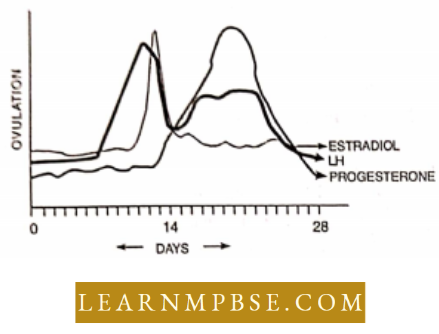
Hormonal Control of Menstrual Cycle. Gonadotropin-releasing hormone (GnRH) also called gonadotropin-releasing Factor (GnRF), is secreted by the hypothalamus of the brain, which stimulates the release of follicle-stimulating hormone (FSH) and luteinizing hormone (LH).
FSH stimulates the ovarian follicles to produce estrogens during the proliferative phase. LH stimulates the corpus luteum of the ovary to secrete progesterone.
- The menstrual phase is caused by the reduction of progesterone and estrogens.
- The proliferative phase is caused by the increased production of estrogens.
- LH causes ovulation.
- The secretory phase is caused by increased production of progesterone.
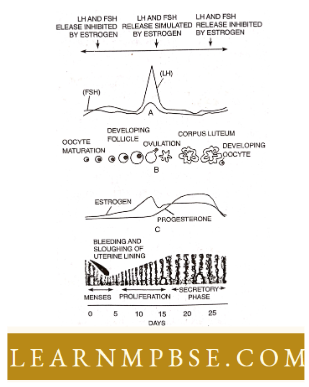
Capacitation: The sperms in the female’s genital tract are made capable of fertilizing the egg by secretions of seminal vesicles, prostate gland, and Cowper’s glands present in the semen itself. This process is called capacitation of sperms. It takes several (5 – 6) hours and involves n change in the properties of the membrane covering the acrosome.
- Sperm lysins
- Hyaluronidase
- Corona penetrating enzyme
- Fertilizin is a chemical that is released by acrosome during fertilization.
Reproduction In Animals NEET
NEET Biology Animal Reproductive System Quanta To Memory

Menstrual Cycle
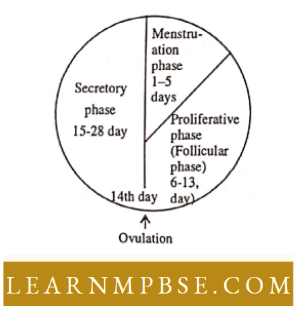
- The menstrual Phase is caused by the reduction of progesterone and estrogens
- The proliferative phase is caused by increased production of estrogen
- LH causes ovulation
- The secretory phase is caused by an increase in progesterone
Fertilization
- Physico-chemical event
- Site-Ampullary -Isthmic junction
- Insemination (single ejaculate contains 300 million sperm)
- The arrival of secondary oocyte stage
- Capacitation of sperms
- Acrosomal reactions
- Sperms Entry
- Karyogamy
- Activation of egg
Placenta
- The Chorionic Placenta Foetal part, chorion, and material part of the decidua basalis
- Nutrition
- Respiration
- storage
- Excretion
- Barrier
- Endocrine Role- Oestrogen, progesterone, HCG Relaxin hp
NEET Biology Animal Reproductive System Questions From Competitive Examinations
Question 1. Which set is similar :
- Corpus luteum – graafian follicles
- Sebum – Sweat
- Bundle of His – Pacemaker
- Vit. B – Niacin.
Answer: 1. Corpus luteum – Graafian follicles
Question 2. The temperature of the scrotum which is necessary for the functioning of
the testis is always below body temperature. This difference is:
- 2°C
- 3°C
- 4°C
- 6°C
Answer: 1.2°C
Question 3. Bartholin glands are situated :
- On either side of the vagina in humans.
- On either side of the vas deferens in human
- On the sides of the heads of some amphibians
- At the reduced tail ends of birds.
Answer: 1. On either side of the vagina in humans.
Reproductive System In Animals NEET Biology Notes
Question 4. The menstrual cycle is affected by :
- Progesterone only
- LH only
- LH + FSH + oestrogen
- Oestrogen only.
Answer: 3.LH + FSH + oestrogen
Question 5. The preparation of sperm before entry into the ovum is called
- Insemination
- Maturation
- Capacitation
- Fertilization.
Answer: 3. Capacitation
Question 6. The oocyte is liberated from the ovary under the influence of LH, after completing ;
- Meiosis and before liberating polar bodies
- Meiosis-I and before liberating polar bodies
- Meiosis
- Meiosis after the release of the polar body.
Answer: 4. Meiosis after the release of the polar body.
Question 7. Which is correct about human embryonic development?
- Cleavage divisions bring about a considerable increase in the mass of protoplasm In the school division.
- one of the two elastomers usually divides a little sooner than the second
- With more cleavage division, the resultant blahs- come Ivconie larger and larger
- Cleiv age division results in a hollow ball of cells called the month
Answer: 2. one of the two elastomers usually divides a little sooner than the second
Question 8. The number of chromosomes in a mature gamete gets halved during :
- Formation of first polar body
- Formation of second polar body
- Meiosis 2
- Division of secondary oocyte and spermatocyte.
Answer: 1. Formation of first polar body
Question 9. Frog’s testes do not possess :
- Interstitial cells
- Seminiferous tubules
- Sertoli cells
- Seminal vesicles.
Answer: 3. Sertoli cells
Question 10. In oogamy, fertilization involves :
- A large non-motile female gamete and a small non-motile male gamete
- A large motile female gamete and a small non-mo- tile male gamete
- A small non-motile female gamete and a large motile male gamete
- A large non-motile female gamete and a small motile male
gamete,
Answer: 4. A large non-motile female gamete and a small motile male gamete,
Asexual And Sexual Reproduction In Animals NEET
Question 11. In human females, ovulation occurs during the menstrual cycle :
- At the end of the proliferative phase
- In the middle of the secretory phase
- Just before the end of the secretory phase
- At the beginning of the proliferative phase.
Answer: 1. At the end of the proliferative phase
Question 12. Nebenkem is a part of:
- Human ovum
- Human sperm
- Fetus
- Graafian follicle.
Answer: 2. Human sperm
Question 13. Yellow-colored milk secreted by cattle soon after the birth of a calf is called :
- Cholesterol
- Colostrum
- Chyme
- Chyle.
Answer: 2. Colostrum
Question 14. In the diagram of the section of the Graafian follicle, different pans are indicated by alphabets. Choose the answer in which these alphabets have been correctly matched with the parts they indicate.
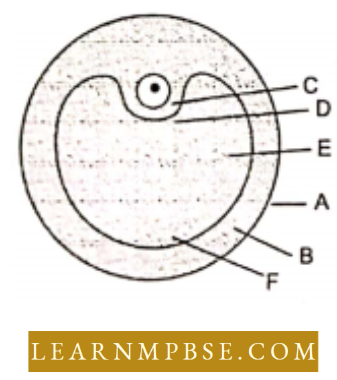
1. A =Membrana granulosa: B = Theca interna;
C = ovum; D = Cumulus rooms: E = Antrum;
F = Theca externa
2. A= Theca externa; B = Theca interna; C = ovum;
D = Mcmbrana granulosa; E = Antrum ;
F = Cumulus oophorus
3. A = Theca externa; B = Theca interna;
C = ovum; D = Cumulus oophorus; E = Antrum ;
F = mcmbrana granulosa
4. A = Membrane granulosa; B = Theca externa ;
C = Ovum ; D = Cumulus rooms ; E = Antruin ;
F =Theca interna
Answer: 3. A = Theca externa; B = Theca interna;
C = ovum; D = Cumulus oophorus; E = Antrum ;
F = mcmbrana granulosa
Question 15. Ovulation in the human female normally takes place during the menstrual cycle :
- At the beginning of the proliferative phase
- At the end of the proliferative phase
- In the mid of the secretory phase
- Just before the end of the secretory phase.
Answer: 2. At the end of the proliferative phase
Question 16. In which of the following organisms testes descend into the scrotum in the breeding season but in non-breeding season?
- Frog
- Kangaroo
- Shrew
- Bat.
Answer: 4. Bat.
Question 17. The proliferation of endometrium of the uterus is controlled by :
- Relaxin
- Oxytocin
- Progesterone
- Oestrogen
- Luteinizing.
Answer: 4. Luteinizing.
Question 18. The type of placenta in sharks is
- Allantoic
- yolk sac
- Hemophilia
- Syndesmochorial.
Answer: 2. yolk sac
Asexual And Sexual Reproduction In Animals NEET
Question 19. Which cell organelle is absent in human sperm?
- ER
- Mitochondria
- Nucleus
- Centrioles.
Answer: 1. ER
Question 20. The origin of the kidney and ureter in Rcina Grinch is
- All mesodermal
- All endodermal
- Ectodermal and mesodermal
- Mesodermal and endodermal.
Answer: 1. All mesodermal
Question 21. Which of the following is ‘immortal’?
- Somatic cells
- Glomerular cells
- Genu cells
- Cells of pituitary.
Answer: 3. Genu cells
Question 22. Grey crescent is an area :
- At the point of entry of sperm into the ovum
- At the animal pole
- Just opposite to site of sperm entry into the ovum
- At the vegetal pole.
Answer: 3. Just opposite to the site of sperm entry into the ovum
Question 23. Wolffian duct forms :
- Epididymis
- Oviduct
- Ejaculatory duct
- Urethra.
Answer: 1. Epididymis
Question 24. A cross-section at the midpoint of the middle piece of a human sperm will show:
- Centriole, mitochondria and 9 + 2 arrangement of microtubules
- Centriole and mitochondria
- Mitochondria and 9 + 2 arrangement of microtubules
- 9 + 2 arrangement of microtubules only.
Answer : 3. Mitochondria and 9 + 2 arrangement of microtubules
Question 25. Which one of the following events is coevally inches with the lime period in a normal menstrual cycle?
- Release of egg = 5 days
- Endometrium regenerate = 5-1O days
- Endometrium secretes nutrients for implantation:11-18days
- Rise in progesterone:1-15days
Answer: 3. Endometrium secretes nutrients for implantation:11-18days
Reproductive System In Animals NEET Previous Year Questions
Question 26. if the mammalian ovum fails to be fertilized, which one of the following is unlikely?
- Corpus him will disintegrate
- Hsitogen secretion I’m decreases
- Primary follicle starts developing
- Progesterone secretion rapidly declines.
Answer: 3. Primary follicle starts developing
Question 27. In which one of the following sets of animals do all four give birth to young ones?
- Lion. hat. whale, ostrich
- Platypus, penguin, bat, hippopotamus
- Shrew, bat. cat, kiwi
- Kangaroo, hedgehog, dolphin, loris.
Answer: 4. Kangaroo, hedgehog, dolphin, loris.
Question 28. Roth corpus lutcum and macula lutea are :
- Found in human ovaries
- A source of hormones
- Characterized by a yellow color
- Contributory in maintaining pregnancy.
Answer: 3. Characterised by a yellow color
Question 29. Sertoli cells are regulated by (the pituitary hormone known as:
- LSI
- GII
- Prolactin
- LI I.
Answer: 1. LSI
Question 30.Withdrawal of which of the following hormones is the immediate cause of menstruation?
- Estrogen
- FSH
- FSH-RII
- Progesterone
Answer: 4. Progesterone
Gametogenesis And Fertilization NEET
Question 31. In the cloning of cattle, a fertilized egg is taken out of the mother’s womb, and :
- In the eight-cell stage, cells are separated and cultured until small embryos are formed which are implanted into the womb of other cows.
- In the eight-cell stage, the individual cells are separated under an electrical field for further development in culture media.
- From this upload eight identical twins can be produced
- Die egg is divided into 4 pairs of cells which are implanted into the womb of other cows. ‘
Answer: 1. In the eight-cell stage, cells are separated and cultured until small embryos are formed which are implanted into the wombs of other cows.
Question 32. In the human female, menstruation can be deferred by die administration of:
- Combination of FSH and LH
- Combination of estrogen and progesterone
- FSH only
- LH only
Answer: 2. Combination of estrogen and progesterone
Question 33. In humans, at the end of the first meiotic division, the male germ cells differentiate into the :
- Spermatids
- Spetmnlogniiili
- Ptimiity spcim.isocyclic
- Secondly spcimaiocylcH.
Answer: 4. Secondnty spcimaiocylcH.
Question 34. Which of the following sliilemeiil’. is incorrect about nicnslriinlion?
- The menstrual fluid can easily clot
- During normal menstruation about 40 ml. of blood is lost
- The beginning of the cycle of incnslrucation is called menarche
- At menopause in the female, there is an especially abrupt increase in gonadotropic hormones.
Answer: 1. The menstrual fluid can easily clot
Question 35. Which one of the following statements about human sperm is correct?
- The sperm lysins in the acrosome dissolve the egg envelope
facilitating fertilization. - Acrosomc serves as a sensory structure leading the sperm toward the ovum
- Acrosomc serves no particular function
- Acrosomc has a conical pointed structure used for piercing and penetrating the egg, resulting in fertilization.
Answer: 4. Acrosomc has a conical pointed structure used for piercing and penetrating the egg, resulting in fertilization.
Question 36. The signals for parturition originate from :
- Placenta as well as a fully developed fetus
- Oxytocin released from the maternal pituitary
- Fully developed fetus only
- Placenta only.
Answer: 1. Placenta as well as fully developed fetus
Reproductive System In Animals NEET Previous Year Questions
Question 37. Sertoli cells are found in :
- The adrenal cortex secretes adrenaline
- Seminiferous tubules provide nutrition to germ cells
- Pancreas and secrete cholecystokinin
- Ovaries and secrete progesterone.
Answer: 2. Seminiferous tubules and provide nutrition to germ cells
Question 38. Which of the following is characteristic of the 27th day of the menstrual cycle?
- Stasis of blood in the basal straight arteries of the endometrium
- Constriction of the coiled spiral arteries
- Increased proliferation of the endometrium
- Increased edema of the functional spongy layer of the endometrium.
Answer: 2. Constriction of the coiled spiral arteries
Question 39. In the male reproductive system :
- Spermatozoa pass in order through efferent ductules, rete testis,
and ductus epididymis. - The ductus deferens, seminal vesicle, and prostate- all have smooth muscle in their walls.
- the seminal vesicle is the main source of acid phosphatase in the semen
- The prostate gland is a site where the maturation of sperm occurs.
Answer: 2. The ductus deferens, seminal vesicle, and prostate- all have smooth muscle in their walls.
Question 40. The figure given below depicts a diagrammatic sectional view of the female reproductive system of humans. Which one set of three parts out of I-Vl have been correctly identified?
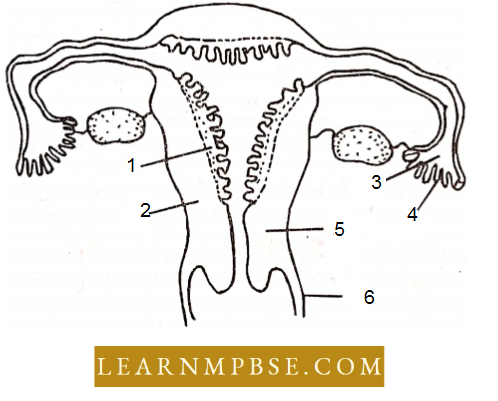
- (2) Endometrium. (3) Infundibulum, (4) Fimbriae
- (4) Ovitlucal funnel, (5) Utenis, (6) Cervix
- (3)Infundibulum, (4) Fimbriae, (5) Cervix
- (1) Perimetrium,(2) Myometrium. (3) Fallopian lube.
Answer: 3. (3)Infundibulum, (4) Fimbriae, (5) Cervix
Question 41. The testes in humans are situated outside the abdominal cavity inside a pouch called the scrotum. The purpose served is for:
- Maintaining the scrotal temperature lower than the internal body temperature
- Escaping any possible compression by the visceral organs
- Providing more space for the growth of epididymis
- Providing a secondary sexual feature for exhibiting the male sex.
Answer: 1. Maintaining the scrotal temperature lower than the internal body temperature
Question 42. If for some reason, the vasa efferentia in the human reproductive system get blocked, the gametes will not be transported from :
- Ovary to uterus
- Epididymis to vas deferens
- Testes to epididymis
- Vagina to the uterus.
Answer: 3.Testes to epididymis
Question 43. The luteal (secretory) phase of the menstrual cycle is characterized by all of the following:
- Coiling or sacculation of endometrial glands
- Decreased amounts of progesterone in the blood plasma
- The presence of a functional corpus luteum
- Atresia of some ovarian follicles.
Answer: 3. The presence of a functional corpus luteum
Question 44. The first movements of the fetus and the appearance of hair on its head are usually observed during which month of pregnancy?
- Fifth month
- Sixth month
- Third month
- Fourth month.
Answer: 1. Fifth month
Question 45. Hie second maturation division of the mammalian ovum occurs:
- Until after the ovum has been penetrated by a sperm
- Until the nucleus of the sperm has fused with that of the ovum
- In the Graafian follicle following the first maturation division
- Shortly after ovulation, the ovum makes entry into the fallopian tube.
Answer: 1. Until after the ovum has been penetrated by a sperm
Question 46. Which one of the following statements about morula in humans is correct?
- It has far less cytoplasm as well as less DNA than an uncleaved
zygote. - It has more or less an equal quantity of cytoplasm and DNA as in
uncleaved zygote. - It has more cytoplasm and more DNA than an uncleaved zygote.
- iDl It has an almost equal quantity of cytoplasm as an uncleaved zygote
but much more DNA
Answer: 1. It has far less cytoplasm as well as less DNA than an uncleaved zygote.
Question 47. During the (sperm to- genesis), the awesome arises by the accumulation of material in :
- Mitochondria
- The nucleus
- The Golgi complex
- The nuclear envelope.
Answer: 3. The Golgi complex
Question 48. Seminal plasma in human males is rich in :
- Glucose and calcium
- DNA and testosterone
- Ribose and potassium
- Fructose and calcium.
Answer: 4. Fructose and calcium.
Question 49. What is correct to say about the hormone action in humans?
- Secretion of thymosin is stimulated with aging.
- In females, FSH first binds with specific receptors on the ovarian cell membrane.
- FSH stimulates the secretion of estrogen and progesterone.
- Glucagon is secreted by P-cells of Islets of Langerhans and stimulates glycogenolysis.
Answer: 2. In females, FSH first binds with specific receptors on the ovarian cell membrane.
Gametogenesis And Fertilization NEET
Question 50. In a normal pregnant woman, the amount of total gonadotropin activity was assessed. The result expected was:
- High level of circulating HCG to stimulate endometrial thickening.
- High levels of FSH and LH in the uterus stimulate endometrial thickening.
- High level of circulating HCG to stimulate estrogen and progesterone synthesis.
- High levels of circulating FSH and LH in the uterus stimulate the implantation of the embryo.
Answer: 1. High level of circulating HCG to stimulate endometrial thickening.
Question 51. Signals for parturition originate from :
- Oxytocin released from the maternal pituitary
- Placenta only
- The fully developed fetus only
- Both placenta as well as fully developed fetus.
Answer: 4. Both placentas as well as the fully developed fetus.
Question 52. The Leydig’s cells as found in the human body are the secretory sources of:
- Intestinal mucus
- Glucagon
- Androgens
- Progesterone.
Answer: 3. Androgens
Question 53. Which one of the following is not the function of the placenta? It:
- Secretes estrogen
- Facilitates removal of carbon dioxide and waste material from embryo
- Secretes oxytocin during parturition
- Facilitates supply of oxygen and nutrients to the embryo.
Answer: 3.Secretes oxytocin during parturition
Question 54. What is the correct sequence of sperm formation ?
- spermatogonia, spermatocyte, spermatozoa, spermatid
- Spermatogonia, spermatozoa, spermatocyte, spermatid
- Spermatogonia, spermatocyte, spermatid, spermatozoa
- Spermatid, spermatocyte, spermatogonia, spermatozoa
Answer: 3.Spermatogonia, spermatocyte, spermatid, spermatozoa

